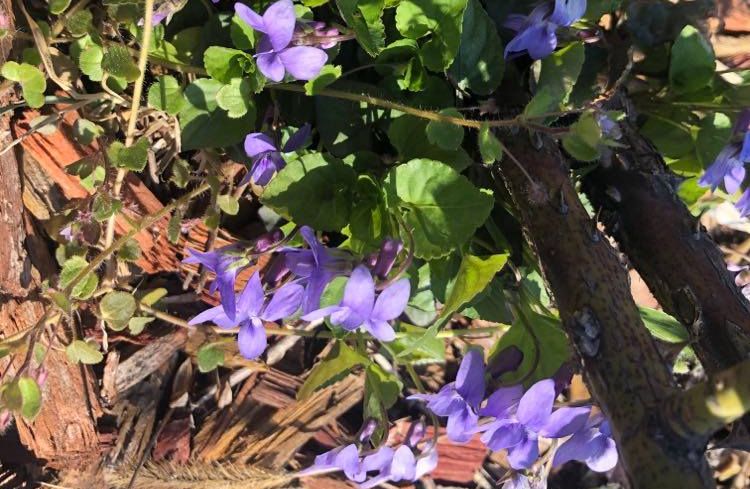Edible flowers/part 1.
The first of our articles introduces the well known and beloved sweet violet.
Interesting facts about violet
Homer portrayed the marriage-bed of Zeus and Hera as a soft violet carpet, in Shakespeare’s “A Midsummer Night’s Dream” Violets were used to create a love potion, Queen Elizabeth’s I. and Empress Elizabeth’s (also known as Sissi) favorite color and flower was Violet, Goethe always brought some violet seeds for his walks which he scattered around the forest, thanking nature this way for all her beauty.
A bit of botanics
The Viola odorata L., the Sweet Violet is a species in the order of Violales, in the family of Violaceae. Traditionally known as herb, it’s drog is it’s rhizome (Violae odoratae rhizoma et radix), but the drug is made by its leaves (Violae odoratae folium), and its flower (Violae odoratae flos) as well.
The Sweet Violet is a perennial flower, long and thin tendrils grow from its rhizome. It has flat leaves, so the flowers grow on the scapes. The leaves are heart-shaped, their point is dull-edged.The stipules are wide and egg-shaped. The petals of the flowers are violet until their stems, rarely pale pink or white and have a good odour. It’s capsules are fluffy. It blooms around March or April, or sometimes even in May. It a European floral element, mainly found in the edges of deciduous forests around bushes.
Medicinal properties
In folk medicine the violet’s rhizome was used first and foremost (as cough mixture or tranquilizer), it was collected early spring or late autumn, they were cleaned, and dried in a windy area. The leaves and flowers can be collected as well, they can be dried in a cool, shady area.
It could be used to make tranquilizing concoction because it contains saponins with triterpene frame and salicylic acid. In Pakistan a group of researchers proved that the antipyretic effect of Sweet Violat is very similar to aspirin. In India Violet is a traditionally used medicine for tonsillitis.
The wonderful smell of the flower
Nowadays, its most commonly used part is its flower because of its irresistible scent. In South-France and Italy its flowers are used to make oil (with extrusion or enflourage), which is one of the world’s most expensive essential oil. Because of this, Violet flowers are used by several world-famous fragrance compositions (Christian Dior: J’adore, Gucci: Gucci II, Yves Saint Laurent: L’ Homme, Givenchy: Extravagance, Armani: Emporio Night). Because its A and C vitamin rich agents, it’s often used in hydrating creams as well.
Usage as a food supplement
Freshly picked petals could be used in salads because of its pleasant color and great taste. Candied flowers could be made out of it as well (be on the lookout for its high sugar content!)
Candied Violet flower:
Ingredients:
-
- Fresh, unwashed Violet with its stem, from a reliable source
- 1 eggwhite
- 2 ts sugar or vanilla sugar
Beat the eggwhie a bit. Plunge the dry Violets into the eggwhie, holding them at their stems. Next we roll them into the sugar. Finally, we cut off the stems and keep the flowers in a hot area or directly under sunlight. (You shouldn’t put them into the owen, as the petals are very sensitive and get burned very quickly)
In our experience they can last for several months.
Resources
Jurca T, Pallag A, Marian E, Mureșan M E, Stan R L, Vicaș L G, The Histo-Anatomical Investigation and the Polyphenolic Profile of Antioxidant Complex Active Ingredients from Three Viola Species, Farmacia, 67, vol 4, 2019, 634-640. http://www.revistafarmacia.ro/201904/2019-04-art-12-Jurca_Pallag_Vicas_634-640.pdf
- Feyzabadi Z, Ghorbani F, Vazani Y, Zarshenas MM, A critical review on phytochemistry, pharmacology of Viola odorata L. and related multipotential products in traditional Persian medicine. Phytother Res., 2017; 31(11): 1669-1675.
- Khattak SG, Gilani SN, Ikram M, Antipyretic studies on some indigenous Pakistani medicinal plants. J Ethnopharmacol., 1985; 14: 45-51.
- Koochek MH, Pipelzade MH, Mardani H, The effectiveness of Viola odorata in the prevention and treatment of formalin-induced lung damage in the rat. J Herbs, Spices Med Plants, 2003; 10: 95-103.
- Vishal A, Parveen K, Pooja S, Kannappan N, Kumar S, Diuretic, laxative and toxicity studies of Viola odorata aerial parts. Pharmacol online, 2009; 1:739-748.
- Stojković D, Glamočlija J, Ćirić A, Šiljegović J, Nikolić M, Soković M, Free radical scavenging activity of Viola odorata water extracts. J Herbs Spices Med Plants, 2011; 17: 285-290.
- T. Jurca, A. Pallag, E. Marian, M.E. Mureșan, R.L. Stan, L.Vicaș, “The histo-anatomical investigation and polyphenolic profile of antioxidant complex active ingredients from three Viola species”, Revista Farmacia, ISSN 0014-8237,67(4), 2019, p. 634-640,
- Siddiqi HS, Mehmood MH, Rehman NU and Gilani AH (2012) Studies on the antihypertensive and antidyslipidemic activities of Viola odorata leaves extract. Lipids in Health and Disease 11,6.
- P. Kumar and Digvijay, “Assessment of genetic diversity of Viola serpens Wall. in Himachal Pradesh using molecular markers,” World Journal of Pharmaceutical Research, vol. 3, no. 2, pp. 2716–2726, 2014.
- Karioti A, Furlan C, Vincieri FF and Bilia AR (2011) Analysis of the constituents and quality control of Viola odorata aqueous preparations by HPLC-DAD and HPLC-ESI-MS. Analytical and bioanalytical chemistry 399, 1715-1723.
- N. Muhammad, M. Saeed, A. A. Awan, and H. Khan, “Ethnomedicinal, phytochemical and pharmacological profile of genus Viola,” Phytopharmacology, vol. 3, no. 1, pp. 214–226, 2012.
The pictures were made by the authors themself.


Recent Comments